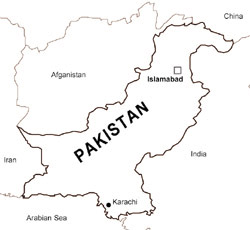|
 The
area of present-day Pakistan has a long history of human
settlement as the cradle of the Indus Valley civilization,
the earliest-known civilization in South Asia. This
Bronze Age culture flourished in the area of the Indus
River Valley from about 2500 to 1700 BC. The Indus River
is considered the lifeblood of Pakistan, and the ancient
culture that arose there serves as an icon of Pakistan's
territorial identity. Important archaeological sites
in Pakistan include Mohenjo-Daro (Sindhi for "Mound
of the Dead"), in Sind Province, and Harappa, near
the Ravi River (a tributary of the Indus) in Punjab
Province. The
area of present-day Pakistan has a long history of human
settlement as the cradle of the Indus Valley civilization,
the earliest-known civilization in South Asia. This
Bronze Age culture flourished in the area of the Indus
River Valley from about 2500 to 1700 BC. The Indus River
is considered the lifeblood of Pakistan, and the ancient
culture that arose there serves as an icon of Pakistan's
territorial identity. Important archaeological sites
in Pakistan include Mohenjo-Daro (Sindhi for "Mound
of the Dead"), in Sind Province, and Harappa, near
the Ravi River (a tributary of the Indus) in Punjab
Province.
Pakistan's cultural identity is traced to the centuries
of Muslim rule in the region. In AD 711 Mohammad bin
Qasim, an Arab general and nephew of Hajjaj, ruler of
Iraq and Persia, conquered Sind and incorporated it
into the Umayyad Caliphate. Thereafter Muslims continued
to rule areas of present-day Pakistan for almost 1,000
years. For the first 300 years the region of Sind was
the only part of the Indian subcontinent that was under
Muslim rule. Muslim rule began to spread to other areas
after the Afghan sultan Mahmud of Ghazni, leader of
the Ghaznavids, invaded in 997. After he conquered the
region of Punjab in the early 11th century, he made
Lahore his capital. Between 1175 and 1186 the regions
of Sind and Punjab were conquered by Muhammad of Ghur,
leader of the Turkish Ghurid Empire, which was centered
in what is now west central Afghanistan. His generals
conquered all of north India by the time he was assassinated
in 1206. That year his general Qutubuddin Aybak laid
the foundations of an independent Muslim kingdom in
India, the Delhi Sultanate. Thirty-five sultans ruled
this rich and powerful sultanate from 1206 to 1526.
The sultanate included most of Punjab and Sind during
this period.
The golden age of Muslim rule in the Indian subcontinent
came with the glory and grandeur of the Mughal Empire
(1526-1858). Between 1526 and 1707 six powerful Mughal
kings ruled in succession: Babur, Humayun, Akbar, Jahangir,
Shah Jahan, and Aurangzeb. As the boundaries of the
empire grew, Islam spread in India through incoming
Muslim rulers, intermarriages, conversions among the
lower Hindu castes, and the teachings of Sufi mystics.
The death of Aurangzeb in 1707 marked the beginning
of the decline of the Mughal Empire, and of Muslim rule
in India.
|


